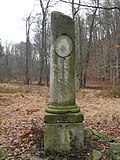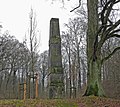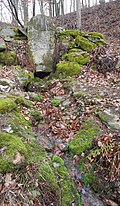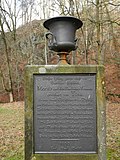List of cultural monuments in the Seifersdorfer Valley
The list of cultural monuments in the Seifersdorfer Tal contains the individual monuments and parts of the Seifersdorfer Tal landscape park , which are listed in the list of monuments of the Free State of Saxony under ID no. 09302337 and 09302338 are shown as a whole . The notes are to be observed.
This list is a partial list of the list of cultural monuments in Wachau (Saxony) and the list of cultural monuments in Schönborn (Dresden) .
Legend
- Image: shows a picture of the cultural monument and, if applicable, a link to further photos of the cultural monument in the Wikimedia Commons media archive
- Designation: Name, designation or the type of cultural monument
-
Location: If available, street name and house number of the cultural monument; The list is basically sorted according to this address. The map link leads to various map displays and gives the coordinates of the cultural monument.
- Map view to set coordinates. In this map view, cultural monuments are shown without coordinates with a red marker and can be placed on the map. Cultural monuments without a picture are marked with a blue marker, cultural monuments with a picture are marked with a green marker.
- Dating: indicates the year of completion or the date of the first mention or the period of construction
- Description: structural and historical details of the cultural monument, preferably the monument properties
-
ID: is awarded by the State Office for the Preservation of Monuments in Saxony. It clearly identifies the cultural monument. The link leads to a PDF document from the State Office for the Preservation of Monuments in Saxony, which summarizes the information on the monument, contains a map sketch and often a detailed description. For former cultural monuments sometimes no ID is given, if one is given, this is the former ID. The corresponding link leads to an empty document at the state office. The following icon can also be found in the ID column
 ; this leads to information on this cultural monument at Wikidata .
; this leads to information on this cultural monument at Wikidata .
Cultural monuments in the Seifersdorfer Valley
This list contains all of the individual monuments and elements that belong to the landscape park Seifersdorfer Tal in terms of monument conservation. Of the former garden monuments in the Park of Sensibility such as huts, pavilions or temples, only a few remains of the wall are left - if at all. Most of the sculptures still exist or have been renewed. The historical significance of this park can be found in the monument text of the State Office for the Preservation of Monuments in Saxony : "The Seifersdorfer Tal landscape park is a romantic park landscape, which is historically, artistically and landscaped with its pathways and landscaped areas and is a unique testimony to garden architecture."
| image | designation | location | Dating | description | ID |
|---|---|---|---|---|---|
 More pictures |
Seifersdorfer Tal (aggregate) |
Seifersdorf , OT von Wachau , in the Seifersdorfer Tal (map) |
1781-1795 | The Seifersdorfer Tal landscape park with the following individual monuments: 12 monuments and three bridges over the Röder (part north of the Röder, Seifersdorf district, ID No. 09283820), mill building (Marienmühle), road bridge, Mühlgraben and weir (part north of the Großer Röder , district Seifersdorf, individual monument ID No. 09283818), three buildings of the former Niedermühle (part north of the Röder, Seifersdorf district, individual monument ID No. 09283819) and 16 monuments (part south of the Röder, Schönborn district, ID No. 09283805) as well Romantic park landscape with all routes and designed areas (garden monument) (material list Schönborn, OT von Dresden , ID no. 09302338) - historically, artistically and landscape design significant, unique testimony to garden architecture. |
09302337 |
 More pictures |
12 monuments and three bridges over the Röder in the part north of the Röder, Seifersdorf district (individual monuments to ID No. 09302337) | Seifersdorf, in the Seifersdorfer Tal (map) |
1781-1795 | Individual features of the Seifersdorfer Valley as a whole - historically and artistically significant. Monuments on the right bank:
1. Altar of virtue |
09283820 |
 More pictures |
(1) Altar of Virtue (individual monument for ID no.09302337) | Seifersdorf, in the Seifersdorfer Tal (map) |
1781-1795 | Individual monument of the Seifersdorfer Tal (in the part north of the Röder) - historically and artistically significant. Note: Altar of virtue and former temple in memory of good people. |
09283820 |
 More pictures |
(2) Linden tree of calm (formerly with armchair of friendship) (individual monument for ID no.09302337) | Seifersdorf, in the Seifersdorfer Tal (map) |
1781-1795 | Individual monument of the Seifersdorfer Tal (in the part north of the Röder) - historically and artistically significant. |
09283820 |
 More pictures |
(3) Ruin of transience (in remnants) (individual monument for ID no.09302337) | Seifersdorf, in the Seifersdorfer Tal (map) |
1781-1795 | Individual monument of the Seifersdorfer Tal (in the part north of the Röder) - historically and artistically significant. |
09283820 |
 More pictures |
(4) Altar of Truth (pedestal with oval inscription plaque) (individual monument for ID No. 09302337) | Seifersdorf, in the Seifersdorfer Tal (map) |
1781-1795 | Individual monument of the Seifersdorfer Tal (in the part north of the Röder) - historically and artistically significant. Note: Altar of truth and former place of forgiveness. |
09283820 |
 More pictures |
(5) Lorenzo's grave and former Lorenzo's hut (individual monument for ID no.09302337) | Seifersdorf, in the Seifersdorfer Tal (map) |
1781-1795 | Individual monument of the Seifersdorfer Tal (in the part north of the Röder) - historically and artistically significant. Note: The name Lorenzo refers to the mendicant monk in the novel Yorick's sensitive journey through France and Italy by Laurence Sterne . Lorenzo's hut was further up on the hillside path. |
09283820 |
 More pictures |
(6) Hermann's oak (in remnants) (individual monument to ID no.09302337) | Seifersdorf, in the Seifersdorfer Tal (map) |
1781-1795 | Individual monument of the Seifersdorfer Tal (in the part north of the Röder) - historically and artistically significant. Note: The Hermann Oak and the Hermann Monument refer to a poem by Klopstock about the historical Arminius . |
09283820 |
 More pictures |
(7) Source of the oblivion of worries (individual monument for ID no.09302337) | Seifersdorf, in the Seifersdorfer Tal (map) |
1781-1795 | Individual monument of the Seifersdorfer Tal (in the part north of the Röder) - historically and artistically significant. |
09283820 |
 More pictures |
(8) Sunset bench, a sandstone slab set in masonry (individual monument for ID no. 09302337) | Seifersdorf, in the Seifersdorfer Tal (map) |
1830 | Individual monument of the Seifersdorfer Tal (in the part north of the Röder) - historically and artistically significant. |
09283820 |
 More pictures |
(9) "The friendly carers of the valley" (individual monument to ID no. 09302337) | Seifersdorf, in the Seifersdorfer Tal (map) |
1824 | Individual monument of the Seifersdorfer Tal (in the part north of the Röder) - historically and artistically significant. |
09283820 |
 More pictures |
(10) Herder monument with an iron bust on a sandstone column (individual monument for ID no. 09302337) | Seifersdorf, in the Seifersdorfer Tal (map) |
1781-1795 | Individual monument of the Seifersdorfer Tal (in the part north of the Röder) - historically and artistically significant. |
09283820 |
 More pictures |
(11) Memorial for Prime Minister Count Heinrich von Brühl (in remnants) (individual monument for ID no.09302337) | Seifersdorf, in the Seifersdorfer Tal (map) |
1781-1795 | Individual monument of the Seifersdorfer Tal (in the part north of the Röder) - historically and artistically significant. Only the four memorial plaques of the Count's original memorial have survived. |
09283820 |
 More pictures |
(12) Amor (single monument for ID no.09302337) | Seifersdorf, in the Seifersdorfer Tal (map) |
1781-1795 | Individual monument of the Seifersdorfer Tal (in the part north of the Röder) - historically and artistically significant. Originally there was a Cupid temple at this point. |
09283820 |
 |
Ludwig Richter memorial stone (individual monument for ID No. 09302337) | Seifersdorf, in the Seifersdorfer Tal (map) |
Individual monument of the Seifersdorfer Tal (in the part north of the Röder) - historically and artistically significant. |
09283820 |
|
 More pictures |
Marienmühle Seifersdorf: Mill building, road bridge, Mühlgraben and weir (individual monuments for ID No. 09302337) | Seifersdorf, Schönborner Weg 3 (map) |
1852 (mill); 1817 (marked with) | Individual features of the Seifersdorfer Valley as a whole - of architectural and local significance. Bridge with keystone in front of the mill building, marked "CGv.B 1817". Note: CGv.B = Carl Graf von Brühl |
09283818 |
 |
Niedermühle Seifersdorf: Three buildings of the former paper mill (individual monuments to ID No. 09302337) | Seifersdorf, Seifersdorfer Tal 6, 6a, 6b (map) |
Around 1890 | Individual features of the entity Seifersdorfer Tal; Former Seifersdorf paper factory - of architectural and local significance. |
09283819 |
 More pictures |
Grundmühle Liegau (at the entrance to the Seifersdorfer Tal) |
Liegau-Augustusbad (OT von Radeberg ), Grundmühlenweg 1 (map) |
1826 | Mill building with rear annex, east and north-west outbuildings and barn of a mill property; Mill building (former guest house), re. in the keystone 1826, eastern outbuilding, upper floor half-timbered (formerly bakery), re. in the basket arch 1802, north-western outbuilding, upper floor half-timbered, possibly old bone mill, wooden barn - of importance in terms of architectural, local and technological history. |
09275320 |
 More pictures |
Seifersdorfer Tal (subject entirety component) |
Schönborn , in the Seifersdorfer Valley (map) |
1781-1795 | Material component of the material group Landscape Park Seifersdorfer Tal (ID No. 09302337) with the following individual monuments: 16 monuments (part south of the Großer Röder, district Schönborn, ID No. 09283805) as well as a romantic park landscape with all paths and designed areas (garden monument) - historical, artistically and landscaping significant, unique testimony to garden architecture. |
09302338 |
 More pictures |
16 monuments and three bridges over the Röder in the part south of the Röder, district Schönborn (individual monuments to ID No. 09302338) | Schönborn, in the Seifersdorfer Valley (map) |
1781-1795 | Individual features of the Seifersdorfer Tal material population (population list ID No. 09302338) - historically and artistically important. Monuments on the left bank:
1. Petrarca's hut |
09283805 |
 More pictures |
(1) Petrarca's hut with the source of Vaucluse (single monument to ID no.09302338) | Schönborn, in the Seifersdorfer Valley (map) |
1781-1795 | Individual monument of the Seifersdorfer Tal (in the part south of the Röder) - historically and artistically significant. |
09283805 |
 More pictures |
(2) Laura's monument on Laurawiese (individual monument for ID No. 09302338) | Schönborn, in the Seifersdorfer Valley (map) |
1781-1795 | Individual monument of the Seifersdorfer Tal (in the part south of the Röder) - historically and artistically significant. Note: Laura was the ideal female figure in Petrarch's poetry. |
09283805 |
 More pictures |
(3) Monument to Leopold von Braunschweig (individual monument for ID No. 09302338) | Schönborn, in the Seifersdorfer Valley (map) |
1781-1795 | Individual monument of the Seifersdorfer Tal (in the part south of the Röder) - historically and artistically significant. |
09283805 |
 More pictures |
(4) Monument to Anna Amalia of Saxe-Weimar and Eisenach (individual monument for ID No. 09302338) | Schönborn, in the Seifersdorfer Valley (map) |
1781-1795 | Individual monument of the Seifersdorfer Tal (in the part south of the Röder) - historically and artistically significant. |
09283805 |
 More pictures |
(5) Obelisk on the road to Schönborn (individual monument for ID no.09302338) | Schönborn, in the Seifersdorfer Valley (map) |
1784 | Individual monument of the Seifersdorfer Tal (in the part south of the Röder) - historically and artistically significant. Note: Obelisk with inscriptions: “Monumentum amoris Christianae com. a Brühl 1784 "(monument of love Christina, Countess von Brühl) and" Dedicated to the best Mr. Hanß Moritz Count von Brühl by the three communities Seifersdorf, Ottendorf and Schönborn. " |
09283805 |
 More pictures |
(6) Stone vase "The Gothic Friendship" (individual monument for ID no. 09302338) | Schönborn, in the Seifersdorfer Valley (map) |
1781-1795 | Individual monument of the Seifersdorfer Tal (in the part south of the Röder) - historically and artistically significant. |
09283805 |
 More pictures |
(7) Monument to the Countess's father (amphora with snake) (individual monument for ID No. 09302338) | Schönborn, in the Seifersdorfer Valley (map) |
1784 | Individual monument of the Seifersdorfer Tal (in the part south of the Röder) - historically and artistically significant. Note: Christina von Brühl's father was Paul Ernst Schleyerweber († 1775). |
09283805 |
 More pictures |
(8) Mountain spring: "Schöpf schweigend" (single monument to ID no. 09302338) | Schönborn, in the Seifersdorfer Valley (map) |
1781-1795 | Individual monument of the Seifersdorfer Tal (in the part south of the Röder) - historically and artistically significant. |
09283805 |
 More pictures |
(9) Remains of the hut of Pythagoras (single monument to ID no.09302338) | Schönborn, in the Seifersdorfer Valley (map) |
1781-1795 | Individual monument of the Seifersdorfer Tal (in the part south of the Röder) - historically and artistically significant. |
09283805 |
 More pictures |
(10) Monument to the young Count Carl von Brühl (individual monument for ID No. 09302338) | Schönborn, in the Seifersdorfer Valley (map) |
1791 | Individual monument of the Seifersdorfer Tal (in the part south of the Röder) - historically and artistically significant. Note: "Monument to the young Count Carl von Brühl, dedicated by his parents on his birthday." |
09283805 |
 More pictures |
(11) Moritz memorial stone on the festival meadow (individual monument for ID no. 09302338) | Schönborn, in the Seifersdorfer Valley (map) |
1824 (1833) | Individual monument of the Seifersdorfer Tal (in the part south of the Röder) - historically and artistically significant. Note: memorial stone “Dedicated to Moritz and the joys of the countryside” on the festival meadow. The memorial was erected in 1824 by Count Carl von Brühl (1772–1837) and his wife Jenny Johanna von Pourtalès (1795–1884) in memory of Hans Moritz and Christina von Brühl. |
09283805 |
 More pictures |
(12) "The singer of the valley - Naumann " column (individual monument for ID no. 09302338) | Schönborn, in the Seifersdorfer Valley (map) |
1781-1795 | Individual monument of the Seifersdorfer Tal (in the part south of the Röder) - historically and artistically significant. |
09283805 |
 More pictures |
(13) Former Alpine Shepherd's Hut (individual monument for ID no.09302338) | Schönborn, in the Seifersdorfer Valley (map) |
1781-1795 | Individual monument of the Seifersdorfer Tal (in the part south of the Röder) - historically and artistically significant. Note: Hut of the alpine shepherdess with the former tomb of her lover Dorestan. The alpine shepherdess Adelaide refers to La Bergère des Alpes by Jean-François Marmontel . |
09283805 |
 More pictures |
(14) Former Bad (single monument for ID no.09302338) | Schönborn, in the Seifersdorfer Valley (map) |
1781-1795 | Individual monument of the Seifersdorfer Tal (in the part south of the Röder) - historically and artistically significant. |
09283805 |
 More pictures |
(15) Stone: "Oh, how beautiful" (individual monument for ID no. 09302338) | Schönborn, in the Seifersdorfer Valley (map) |
1820 | Individual monument of the Seifersdorfer Tal (in the part south of the Röder) - historically and artistically significant. Stein: "Oh how beautiful" (exclamation from Count Carl's wife, Johanna von Pourtales in the face of the beautiful valley) with the inscription: "For Johanna and Moritz - 1820." |
09283805 |
 More pictures |
(16) Pan statue (lost) (individual monument for ID no.09302338) | Schönborn, in the Seifersdorfer Valley (map) |
1781-1795 | Individual monument of the Seifersdorfer Tal (in the part south of the Röder) - historically and artistically significant. |
09283805 |
Remarks
- This list is not suitable for deriving binding statements on the monument status of an object. As far as a legally binding determination of the listed property of an object is desired, the owner can apply to the responsible lower monument protection authority for a notice.
- The official list of cultural monuments is never closed. It is permanently changed through clarifications, new additions or deletions. A transfer of such changes to this list is not guaranteed at the moment.
- The monument quality of an object does not depend on its entry in this or the official list. Objects that are not listed can also be monuments.
- Basically, the property of a monument extends to the substance and appearance as a whole, including the interior. Deviating applies if only parts are expressly protected (e.g. the facade).
Detailed memorial texts
- ↑ Seifersdorfer Tal: Deep, winding valley of the Großer Röder of over 2 km in length, redesigned by Countess Christina von Brühl in a romantic park landscape since 1781, which became a magnet for the artists of the Romantic era . Wilhelm Gottlieb Becker's copper work, published in 1792 , has already shown over 40 monuments scattered across the valley landscape. The design interventions in nature were limited to a minimum, mostly only lines of sight were exposed. Many monuments, such as the replica of the hut of Petrarch with the spring of Vaucluse (where the poet is said to have written his love songs for Laura), the hermit's prayer chair or the hut of solitude were only made of wood and straw and thus exposed to perishability. Other monuments that no longer exist were: Monument “Punishment of Future Determination” (urn with a butterfly) / Temple of the Muses with Wieland's bust / Temple of Good Moritz / Lorenzo's Hut / Temple of Charity / Garden Hut of the Alpine Shepherdess and Dorestan's tomb.
- ↑ The Seifersdorfer Tal corresponded to the natural ideal of the late 18th century with its charming small-scale landscape and the picturesque rocky areas and meadow areas along the river Große Röder. However, the valley first became famous through the activities of Hanns Moritz von Brühl and Christina von Brühl , who, as amateur gardeners, followed the suggestions of the great gardening theorist of the 18th century, Christian Cajus Hirschfeld (1742–1792), created the creations of nature through works by Art elevated. They created one of the earliest landscape gardens in Germany and at the same time exceeded the boundaries of the landscape garden, because the valley was, as noted in the “Pocket Calendar for Nature and Garden Friends 1795”, “not both a garden and an embellished forest”, a “pattern the refinement of wild nature ”, although“ the renewed garden art was actually called to help ”. Hanns Moritz von Brühl, born in 1746 as the youngest son of the influential Saxon Prime Minister Heinrich von Brühl , was familiar with the most progressive Saxon garden creations of that time on the numerous estates of his parents from childhood. As part of his training, however, he also had early contact with the ideas of the Enlightenment, for example through his lifelong friendship with the poet Gottlieb Konrad Pfeffel (1736–1809). The defeat that Saxony suffered in the Seven Years' War was also the financial ruin of the Brühl family. After Heinrich von Brühl's death, the property was sequestered on suspicion of embezzlement, and many possessions were subsequently lost. Hanns Moritz had to be content with the modest Seifersdorf estate - a property in Brühl since 1747, in which little investment had been made to date. Since the old moated castle from the Renaissance was uninhabitable, the couple - Hanns Moritz had married the Alsatian officer's daughter Christina Margarita Schleyerweber in 1771 - moved into the manor house of the manor house, which can almost be called poor. It was an unsuitable dwelling - not far from the count's living room, the chickens scraped in the dung. But the Brühls made a virtue out of their middle-class rural lifestyle, in line with the credo of the time. As a contemporary critic wrote: “What distinguishes the whole thing from the mere sensibility of so many others is that here people from enjoying everything that the glorious appearances of life in the higher classes offer to enjoying the loneliness, innocence and simplicity of the people Nature has returned when others have only imagined one thing and the other. ”Nevertheless, from today's perspective it is surprising that the Brühls did not try first to improve their unfortunate living conditions, but rather put all their energy and very limited financial resources into practice for the creation of a valley that was a quarter of an hour's walk away. In the area of the valley meadows and on the mountain slopes, they created over forty self-contained garden scenes, which were often linked by visual relationships. The valley's vegetation, which due to the lack of wood and other forms of forest management at that time probably did not cover the rocks to the same extent as it does today, was hardly changed and only a few foreign plants were added in the area of the scenes. The ideas and drafts for the design of the facility are likely to go back as far as possible to the Countess, even though the Count himself lent a hand in the execution. First of all, due to the tight family budget, it was implemented with the simplest of means. Tina wrote in 1795: "... in order to save costs almost all monuments were made of wood, which are now made of stone with the exception of a few ...". The busts on display were casts from the workshop of the Weimar court sculptor Martin Gottlieb Klauer (1742–1801), which were later replaced by cast iron from Lauchhammer. The Brühls designed the facilities in the valley less for their own use, but rather, with an initially unshakable enlightenment optimism, for the ethical and didactic education of the population. The Seifersdorfer Tal, a popular excursion destination to this day, was open to all social classes. In addition to the names of princes and counts, the visitor book also records the entries made by the residents of the surrounding villages, often consisting of only three crosses. Among the visitors to the valley, there are also illustrious names such as Jean Paul , who found the valley “heavenly”. Christoph Martin Wieland , Christian Gottlieb and Theodor Körner , Caspar David Friedrich , Johann Gottfried Schadow , Elisa von der Recke or Zacharias Werner . The Brühls' concern has always been to gather artists and promote them, especially with a view to the development of a German national culture. (From: Guide through the famous Seifersdorfer Valley. Berlin 1994, afterword by Kathrin Franz.)
literature
- Wilhelm Gottlieb Becker : Das Seifersdorfer Thal , Leipzig, 1800, 36 p. Online from the Berlin State Library (accessed on February 19, 2019)
- Wilhelm Gottlieb Becker: Das Seifersdorfer Thal , Leipzig: Voss and Leo, 1792. online from the University and State Library Düsseldorf (accessed February 19, 2019)
- Kathrin Franz: Das Seifersdorfer Tal , in: Gardens of the Goethe Time , Leipzig, 1993, pp. 133–142
- Karl Josef Friedrich : Guide through the famous Seifersdorfer Valley , Stapp Verlag Berlin, 2007, 103 pages, ISBN 978-3-87776-4-527 (reprint of an edition from 1930)
Web links
- Seifersdorfer Thal eV Association - Landscape Garden (accessed on February 19, 2019)
- In the Seifersdorfer Tal (accessed February 19, 2019)
- Stories from Saxony - The Seifersdorfer Tal (accessed on February 19, 2019)

